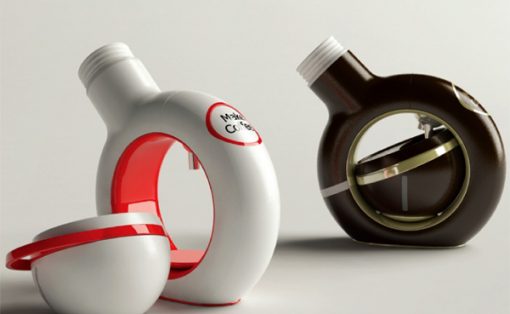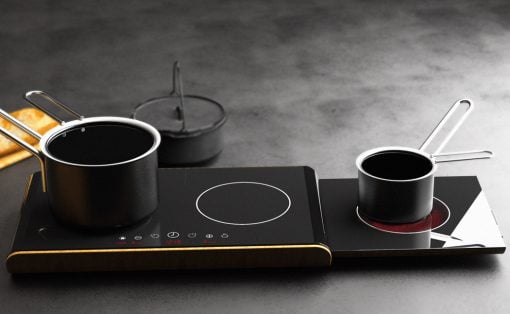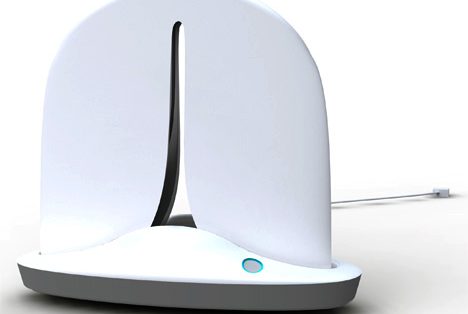
Material innovation takes center stage at Copenhagen’s 3 Days of Design festival next week, as four international brands present new approaches to sustainable manufacturing. From furniture made with volcanic waste to chairs crafted from 29 layers of paper, the presentations demonstrate how established manufacturers are changing traditional production methods through distinct material strategies.
Armadillo Debuts Seven-Piece AGRA FORMA Collection
Australian rug manufacturer Armadillo enters furniture design through AGRA FORMA, a collaboration with Sydney designer Tom Fereday that comprises seven sculptural pieces anchored by the brand’s iconic Agra rug. The collection includes the Agra Forma Armchair in Ginger, Agra Forma Stool in Thistle, Agra Forma Ottoman available in both Ginger and Thistle colorways, Agra Forma Desk in Thistle, Agra Forma Chair in Thistle, and Agra Forma Low Stool in Ginger.

Key Details:
- Material Integration: Pure abrash-dyed wool and American red oak timber unite textile and woodworking craftsmanship in shared geometric language
- Design Philosophy: Tom Fereday’s approach celebrates natural material characteristics without overworking design, creating “honest and enduring” objects
- Dual Launch Strategy: Collection debuts simultaneously at Copenhagen’s 3 Days of Design and Melbourne Design Week (May 15-25, 2025)

Each piece demonstrates what Armadillo describes as “a refined exploration of materiality, form and the poetic potential of the handmade.” The collection pairs the sun-baked depth of Agra Ginger with the muted cool of Agra Thistle, anchored by the raw integrity of American red oak timber. Sculptural curves and deliberate forms create contrast in refined yet balanced compositions.

Fereday’s design philosophy centers on celebrating “the natural characteristics of natural materials to not overwork a design rather enhance the material and experiential interaction with an object.” His approach emphasizes the tension between natural materials and contemporary manufacture, seeking to create objects that are “honest and enduring.” The designer works at every stage of design, from concept through production and development alongside skilled makers, interrogating the role objects play in contemporary spaces.

The disciplines of rug-making and fine woodwork intersect in a shared language of minimalism and tactility. The raw beauty of sustainable materials, including pure abrash-dyed wool and red oak, are changed into vessels for innovation that transcend the ancient and modern. Each piece articulates what the collaboration calls “a quiet architecture,” inviting a sensory dialogue between surface, structure and space.

The collection launches at The Conary (Dronningens Tværgade 26) within Openhouse Studio’s “Gestures of Home” exhibition, styled by Henriette Schou. Armadillo co-founder Jodie Fried and designer Tom Fereday will be present for the press preview Tuesday, June 17, 9AM-6PM, with a cocktail party Wednesday, June 18, 3PM-6PM.
Arper Advances Sustainable Seating Through PaperShell Innovation
Italian manufacturer Arper presents two sustainable seating solutions at Odd Fellow Palace, building on a 23-year design legacy that began with the original Catifa 53 in 2001. Designed by Lievore Altherr Molina, the Catifa collection was Arper’s first product with an environmental product declaration, establishing the brand’s commitment to sustainable design practices.

Key Details:
- Carbon-Negative Production: PaperShell technology sequesters 1.5kg CO2 equivalent per kilogram of material, converting to biochar at end-of-life
- Waste Stream Utilization: 29 sheets of kraft paper sourced from Swedish wood production residues (sawdust, chips, branches) with no trees cut specifically
- Dual Material Strategy: PaperShell collection alongside Catifa (RE) 46 chairs made from 100% recycled plastic with BREATHAIR cushioning
The Catifa Carta 46 collection uses PaperShell technology, where 29 sheets of responsibly sourced kraft paper bonded with natural resin create chair shells that match traditional plastic durability while offering complete recyclability. The paper originates from Swedish wood production residues including sawdust, chips, and branches, ensuring no trees are explicitly cut for the material. Each kilogram of PaperShell sequesters approximately 1.5 kilograms of CO2 equivalent, making the chairs carbon-negative throughout their lifecycle.

At end-of-life, the chairs undergo pyrolysis, converting the material to biochar that locks carbon permanently while preventing CO2 release into the atmosphere. The original Catifa design, characterized by its bi-curved silhouette and all-in-one shell construction, helped define Arper’s brand personality over two decades. The new PaperShell iteration maintains this iconic form while advancing the company’s circular design principles through material innovation.

Arper also introduces Catifa (RE) 46 chairs made from 100% recycled plastic sourced from post-consumer and post-industrial waste streams. Eight new color options draw inspiration from sustainable architecture, emphasizing exposed materials and natural textures that complement contemporary interior design trends. The collection includes BREATHAIR cushioning, an elastomeric polyester material that provides breathability, water resistance, and full recyclability. The cushioning has been precisely shaped for the first time to fit Catifa specifications, merging comfort with sustainable material innovation.

The exhibition runs Wednesday-Friday at Bredgade 28, with press previews Wednesday, June 18, 12PM-4PM.
Foscarini Presents Dual Lighting Innovations
Italian lighting manufacturer Foscarini presents two major collections at Alice Folker Gallery: the Eolie Collection featuring chandeliers made from recycled lava stone, and the Etoile chandelier series designed by Dordoni Studio. The presentations demonstrate Foscarini’s approach to material experimentation alongside contemporary chandelier design.

Key Details:
- Volcanic Waste Transformation: Eolie Collection by Alberto and Francesco Meda converts recycled lava stone into functional lighting while preserving natural crater textures
- Transparent Structure Design: Etoile chandeliers use invisible Pyrex cylinders for support, creating floating effect with etched glass diffusers
- Dual Configuration Options: Grande Etoile (three-level) and Etoile Ronde (single-level) versions with silver-finished bulbs for optimal light distribution

The Eolie pieces, designed by Alberto and Francesca Meda, incorporate recycled lava stone that retains the porous, crater-like surface textures characteristic of cooled volcanic material. Alberto Meda, born in 1945 and trained as a mechanical engineer at Milan Polytechnic, brings decades of material innovation experience to the collaboration. His design philosophy emphasizes “lightness as a paradigm,” seeking to “produce a simple appearance while using complex technology to solve a problem.”

The father-son design team combines Alberto’s engineering background with Francesco’s focus on traditional craftsmanship. Alberto’s experience as technical manager at Kartell from 1973, where he developed plastic laboratory equipment and furniture projects, informs his understanding of material possibilities and manufacturing constraints. Francesco Meda, born in 1984 and educated at Milan’s Istituto Europeo of Design, gained experience at Sebastian Bergne’s and Ross Lovegrove’s studios in London before returning to collaborate with his father.

Foscarini also presents Etoile, designed by Dordoni Studio, which changes the concept of the chandelier while conserving its intrinsic allure. The design substitutes rich decoration of traditional chandeliers with a refined game of volumes. Contrast between the transparency of the central cylinder in Pyrex and the texture of etched glass diffusers creates balance between opposing elements.

Etoile comes in two versions: Grande Etoile with a configuration on three levels, and Etoile Ronde with a single level. No visible structural element appears at the center, with support for the lighting modules provided by a cylinder of transparent Pyrex that becomes almost imperceptible when the chandelier operates. Slender cylinders branch out from this core to sustain diffusers in blown glass of different sizes, arranged on staggered levels in the Grande model, and as an array in the Ronde version.

The cylinder contains the electrical wiring, left free to move, changing the concept of the arm in a minimal form. In Grande Etoile, the portions of glass vary at different levels: in the upper and lower planes they correspond to two thirds of a cylinder, while at the middle level they take the form of half circumferences, the same pieces utilized in the Etoile Ronde version.

Bulbs with silver frontal finish attach at the center of each diffuser, aiming light towards the glass and allowing the etched diffuser to absorb and then release it. The glass becomes the protagonist, producing soft, enveloping glow and spreading indirect, diffused and atmospheric effects.

The exhibition includes aperitivo events Wednesday and Thursday, 4:30-5:30PM, plus “The Art of Enlightenment” talk Friday, 10:30-11:15AM at Esplanaden 14, with Head of Design Matteo Urbinati leading technical discussions.
Ingo Maurer Challenges Perception with Three New Concepts
German lighting designer Ingo Maurer presents three pieces at Alice Folker Gallery: Nalum, SHHH!, and Jasna Kuchnia. Each design explores the relationship between light, material properties, and visual perception through the late designer’s philosophy of working with “the material which does not exist.”

Key Details:
- Wave Motion Technology: Nalum uses floating glass tubes with magnetic LED positioning to create shifting light patterns inspired by ocean waves and water reflection
- Perception Deception: SHHH! hides light source within noise-canceling headphones while visible bulb remains unlit, challenging conventional lighting expectations
- Porcelain Light Sculpture: Jasna Kuchnia transforms five white plates into wall-mounted lighting with LED backlighting and matchstick ignition illusion
Nalum translates the dynamics of waves and light into a lighting object inspired by the movement of ocean waves and the play of light reflections on water surfaces. The name combines ‘Nalu’, the Hawaiian word for wave, and ‘Lum’, an allusion to light. In addition to the physical meaning of ‘wave’, ‘nalu’ stands for reflection and contemplation. At the center sits a floating, undulating glass tube, illuminated from the outside. The contours of the glass create lines of light through multiple reflections, making Nalum appear to be made entirely of water and light.

The visual lightness results from precise use of glass as material. The wave-shaped inner tube, illuminated from the outside, creates complex interplay of lines, depth, and movement through reflection and refraction. The outer glass tube acts as a calm frame, stabilizing the form, enhancing the light effect, and making technical elements almost disappear. The linear light source integrates discretely, held in place by magnets in the outer glass tube and providing uplight and downlight. This makes Nalum suitable for long tables, such as dining or conference tables, and for spaces where targeted and atmospheric lighting is required. The lighting components can be dimmed independently and produce warm white light of 2700 K.

SHHH! subverts expectations and plays with perception through an unusual encounter between an accessory connected with industrial labor and a light source that paradoxically emits no light. What at first glance seems like a light source is something else again. As in an orchestrated illusion, the true source of light is not the visible bulb, but is hidden inside the noise-proof headset. The light spreads through the bulb into the space, creating an evocative atmosphere. Two directional spots positioned in the lower part of the headset project accent lighting onto surfaces below, combining visual impressions with functional quality.

Jasna Kuchnia consists of five simple white porcelain plates arranged vertically with a narrow LED strip that backlights the porcelain. The light is not diffused but absorbed, refracted, and reflected in subtle gradients of brightness. This interplay creates a vibrant choreography of light and shadow, giving the plates a sculptural presence. The synergy between porcelain and light shows the strength of the design, making the hard, smooth material appear weightless and translucent when illuminated.
Technical specifications include LED, 100/240V, 15.3W, 2700K, CRI ≥ 90, with dimensions of Width 22cm x Height 61cm x Depth 13cm. The fixture mounts directly to the wall with the driver discretely integrated into the wall bracket, making additional installation components unnecessary. The springs holding the plates can be shifted laterally, allowing users to choose strictly vertical alignment or a slightly offset configuration. Multiple elements can be combined for larger installations ranging from ten plates or more in a row.

The frontmost plate features a small, dark matchstick that blends into the overall composition. When the light turns on, the signature charm of an Ingo Maurer design appears: shining through the ceramic, the light source appears to ignite the match, and a warm yellow flame begins to glow.
Axel Schmid, Head of Product and Project Design, leads “Playfulness & Irony in Modern Art & Design” discussion Thursday, 10:30AM.
Festival Context and Material Innovation Impact
The presentations demonstrate how material innovation drives contemporary design development, with each brand addressing sustainability through distinct philosophical approaches. Tom Fereday’s celebration of natural material characteristics, the Meda family’s engineering-informed simplicity, Lievore Altherr Molina’s environmental consciousness, and Ingo Maurer’s perceptual experimentation represent different pathways toward responsible design practice.
The festival features over 200 exhibitions across eight Copenhagen districts, with press appointments coordinated centrally and several venues within walking distance. Copenhagen’s 3 Days of Design runs June 18-20, 2025, with extended hours for trade visitors and media representatives. The presentations collectively showcase how material innovation drives sustainable design development, from natural fiber and timber integration to bio-based composites, waste material change, and conceptual challenges to conventional manufacturing approaches.






